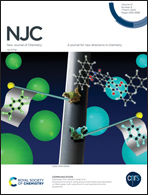Heteroleptic copper(i) complexes bearing functionalized 1H-pyrazole-bipyridine ligands: synthesis, photophysical properties, crystal structures, and applications in halogen sensing†
Abstract
A series of new heteroleptic copper(I) complexes [Cu(N^N)(P^P)][BF4] (1–6), where N^N is a pyrazole-substituted 2,2′-bipyridine (5-(1H-pyrazol-4-yl)-2,2′-bipyridine (5-pzbpy, L1), 4,4′-di(1H-pyrazol-4-yl)-2,2′-bipyridine (4,4′-pz2bpy, L2), 5,5′-di(1H-pyrazol-4-yl)-2,2′-bipyridine (5,5′-pz2bpy, L3), and 3,8-di(1H-pyrazol-4-yl)-1,10-phenanthroline (3,8-pz2phen, L4)) and P^P is either oxybis(2,1-phenylene)bis(diphenylphosphane) (POP) or 1,3-bis(diphenylphosphanyl)propane (dppp), were successfully prepared and investigated. The crystal structures of 1, 2, 3 and 6 were determined by single X-ray diffraction. The novel copper(I) complexes 1, 2 and 3 show turn-on emission sensing for halogen ions. The fluorescence enhancement of the copper(I) complexes increases in the order of F− < I− < Br− < Cl−, and the differences in fluorescence intensity could be easily distinguished with the naked eye under UV light illumination. The 1H NMR titration indicated that the interaction involves hydrogen-bond formation between the halide (Cl−, Br− and I−) and the acidic H of the pyrazole group, with N–H deprotonation occurring at increasing F− concentrations. The result was further confirmed by carrying out theoretical calculations.



 Please wait while we load your content...
Please wait while we load your content...